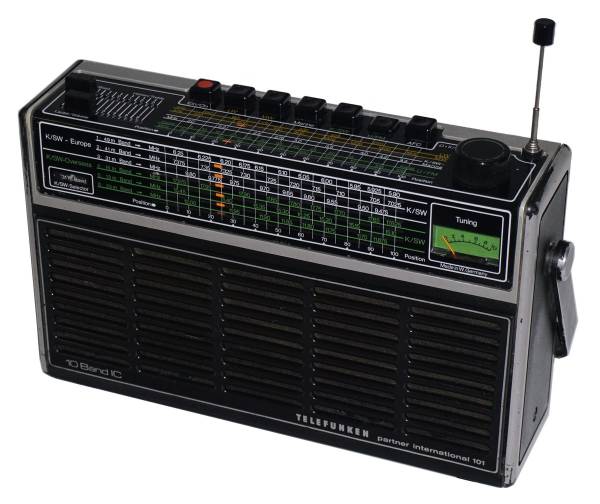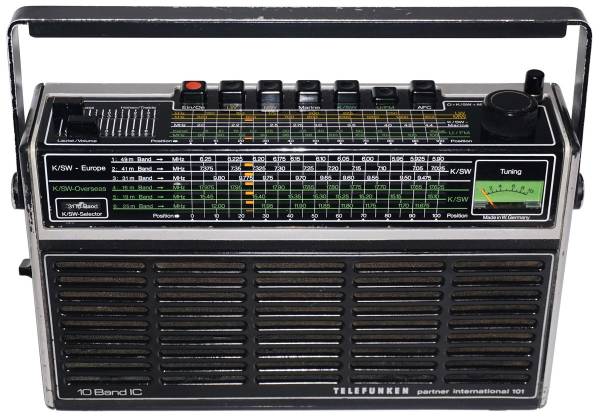Inhaltsverzeichnis
Telefunken partner international 101
Manufactured by Telefunken.
The Telefunken partner international 101 portable receiver was introduced around 1975, it is an analogue world band radio with six spread shortwave bands in double conversion technology.
Technical data
- Principle: Double conversion superhet, IF 3750 / 460 kHz (ranges SW1-6), 460 kHz (LW, MW, MB) / FM 10.7 MHz
- Frequency range: FM broadcast band, LW, MW, maritime communications band (2 - 4.5 MHz), 6 x SW (49 - 16 mb)
- Frequency display: analogue dial
- Frequency memory: none
Power supply
- Mains operation: 220 V
Dimensions
- 300 x 170 x 75 mm, weight kg
Accessories
Operation
The Telefunken partner international 101 portable radio has a compact design and is surprisingly heavy compared to its size - there are other sets with an impressive large cabinet and little „content“. The shortwave radio bands 49 - 16 m are received using double conversion superheterodyne, off-band frequencies cannot be tuned, so the set is not general coverage.
The portable radio is dominated by an angular „round the corner“ dial in the upper part of the front panel and on the upper face. On the top face are the dials for long and mediumwave, the "marine band" 2 - 4.5 MHz and the FM broadcast band.
On the front face are the dials for the shortwave broadcast bands with frequency marks every 50 kHz. In a small window, the active shortwave band is indicated; it is set with the wave selector knob acting on a turret tuner on the left face of the set.
At the top are the slider controls for volume and tone control (linear potentiometers, they are somewhat susceptible to corrosion and dust), next to them is the push-button switch unit with the main power switch and the waveband buttons.
The set is powered by six UM-2 batteries. The mains cable compartment on the underside opens when the semicircular cover on the battery / mains cable lid is turned accordingly and the opening of the lid is released.
The left red button turns on the receiver, the band range is selected with the push-buttons: longwave / mediumwave, the maritime communications band between 2 - 4.5 MHz, the shortwave ranges (K/SW, the desired broadcast band can be selected with the band switch on the left face of the set and its displayed in a small window) or FM broadcast band. The tuning knob, which is commonly used in all ranges (in contrast to the Nordmende Globetrotter 808 with a similar design and two tuning knobs for L / M / MB / FM broadcast band and shortwaves) at the right is used to hunt for stations.
In the spread shortwave boraadcast bands 1 - 6, the set works as a double conversion superhet with a moderately high first IF of 3750 kHz and the usual second IF of 460 kHz, the mirror frequency rejection is better than with the standard single conversion superhets.
The tuning has no play after the years. The problem with the set seems to be the FM broadcast band, the receiver was aligned for high sensitivity and can show problems with mirror frequencies or „ghost stations“ at the wrong dial position, with the antenna half way inserted, these effects are less pronounced. When the AFC is switched on, the AFC pulls to the next strong station. The tuning can also show some hysteresis, when turning back and forth, a weak station may not appear at all or not exactly at the same place on the dial.
Technical principle
 Double conversion superhet with a first IF of 3750 kHz on SW ranges 1 - 6, the second IF of 460 kHz is also used as IF for L/M/MB in single conversion mode.
Double conversion superhet with a first IF of 3750 kHz on SW ranges 1 - 6, the second IF of 460 kHz is also used as IF for L/M/MB in single conversion mode.
Components
The set is equipped with semiconductors.





